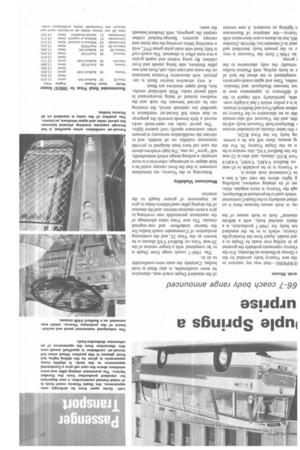luple Springs a urprise
Page 39

If you've noticed an error in this article please click here to report it so we can fix it.
66-7 coach body range announced
erek Moses iURPR1SE—that was my reaction to the new Viceroy body unveiled by the e Group at Hendon on Monday. For the Viceroy represents probably the greatest ;e in styling ever made by Duple to a ard model. Apart from the frontal grille iriceroy, which is to be the standard Ion body for 1966-7 production, is a detely restyled body, with a definite dinentar look in both senses of the tay in both senses because there is an ubted similarity to the Duple Continental which used to be produced at Blackpool, ugh the Viceroy is more angular. Also, ise of its sloping windows, including g lights above me cant rail, it has a de Continental look about it.
ie Viceroy is to be available in 45-seat on Bedford VAM3, VAM5, VAM14 Ford R192 chassis, and also in 52-seat for the Bedford VAL, this version to be n as the Duple Viceroy 36. For the ig season, there will not be a corresng body for the Ford R226.
r this latter chassis, an extended version Blackpool-built Viscount body will be tble, and the Viscount will also remain tble as an alternative to the Viceroy on edium-length Ford and Bedford chassis. is is a policy which I feel is highly cornable, particularly with regard to the 11 difference in appearance now in ice between Blackpooland Hendon3odies. Time and again coach operators complained to me about the lack of e in body styling, with Pluton bodies virtually the only alternative to the group.
its 1966-7 form the Viscount is very .r to the present body described and ated in COMMERCIAL MOTOR, October )65, but its shares a new innovation with ticeroy—the adoption of fluorescent a lighting as standard. A new version of the standard Duple coach seat, claimed to be more comfortable, is also fitted in both bodies. Certainly the seats were comfortable to sit in.
The 1966-7 coach range from Duple is to be completed with a longer version of the 29-seat Vista on Bedford VAS chassis to be known as the Vista 25, and the continuing production of Commander coach bodies for the heavier underfloorand rear-engined chassis. The new Vista takes advantage of the maximum permissible rear overhang to give a more spacious interior, and the absence of the sloping pillar used hitherto helps to give an impression of greater length to the exterior.
Maximum Visibility
Returning to the Viceroy, my immediate comment is that the front canopy could be a little deeper to advantage; otherwise it is most certainly a striking design which undoubtedly will "grow" on one. The high windows above the cant rail have been designed to provide maximum visibility on all models, and to obviate the modification necessary at present when customers specify roof quarter lights.
The parcel racks are open-mesh racks moved a little inwards towards the gangway so that when full forced-air ventilation is specified (an optional extra), the trunking can be carried between the rack and the windows instead of being incorporated in solid parcel racks. With individual ventilation, fixed upper windows are fitted.
A very attractive interior finish is employed, with decorative Formica laminates on the waist and cant rails, cab, front and rear pillar finishers, side lining panels and front cabinet. By using walnut and sapele grains a two-tone effect is obtained. The coach roof is fully lined with otaki polar green PVC, with a matching fabric covering the rear dome and canopy quarters. Sponge-backed rubber carpets the gangway, with linoleum beneath the seats.




























































































































